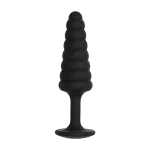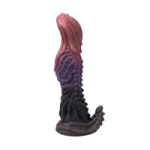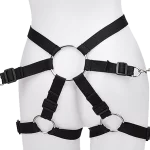Restorers at St. Andrew’s Church in Eisleben, in the state of Saxony-Anhalt in east-central Germany, discovered four bags of coins dating from around 1640 in the leg cavity of a statue of a kneeling count. During the Thirty Years’ War (1618-1648), Swedish occupying forces wreaked havoc in the area, forcing local residents to house, feed and pay large sums of cash for them, which they stashed in the Count’s legs.
 Conservators discovered the treasure in 2022. The leather bag contained 816 coins, including a highly valuable “Golden Angel” coin, several gold coins, gold and silver doubles, half and quarter seles, and 800 pence. In an era when miners earned 24 pence (1 taler) a week, this was a huge sum of money.
Conservators discovered the treasure in 2022. The leather bag contained 816 coins, including a highly valuable “Golden Angel” coin, several gold coins, gold and silver doubles, half and quarter seles, and 800 pence. In an era when miners earned 24 pence (1 taler) a week, this was a huge sum of money.
The most valuable gold coins were wrapped in paper and labeled, indicating that the money belonged to the church treasury. “This is not a Sunday cloche bag, though,” [head of the State Coin Cabinet of Saxony-Anhalt Ulf] Draeger said. “Rather, it is income collected from special services performed by priests” such as weddings, baptisms and funerals. Pastors also receive money from “chair fees,” in which congregants pay to sit in prominent seats in church, he added.
Historians know that from 1561 Eisleben had an “Aerarium Pastorale” – a public parish fund that served as a pension and medical fund, social insurance for priests and to promote the training of theologians. “Maybe we already have the fund now,” Draeger said. “Historical research will prove that.”
 Martin Luther was born in Eisleben in 1483 and died there in 1546. He preached his last four sermons from the pulpit of St. Andrew’s Church, and his funeral was held there, but his remains were taken to Wittenberg for burial. Elector of Saxony. In Luther’s time, Eisleben was the capital of the county of Mansfield, ruled by the earls of the Mansfield family, some of whom converted to Protestantism and broke away from the Catholic Church and the Holy Roman Emperor to follow Martin Luther. Luther acted as an intermediary between the Catholic and Protestant Earls of Mansfield, negotiating a unique truce in the bitter conflict of the Reformation: St. Andrew’s Church held Catholic Mass in the morning and Protestant services in the afternoon. In fact, Luther was in town only because he was settling another dispute between the Mansfield families. He arrived in January, fell ill rapidly and died on 18 February. His body lay in state at St. Andrew’s Church for four days before being transported to Wittenberg.
Martin Luther was born in Eisleben in 1483 and died there in 1546. He preached his last four sermons from the pulpit of St. Andrew’s Church, and his funeral was held there, but his remains were taken to Wittenberg for burial. Elector of Saxony. In Luther’s time, Eisleben was the capital of the county of Mansfield, ruled by the earls of the Mansfield family, some of whom converted to Protestantism and broke away from the Catholic Church and the Holy Roman Emperor to follow Martin Luther. Luther acted as an intermediary between the Catholic and Protestant Earls of Mansfield, negotiating a unique truce in the bitter conflict of the Reformation: St. Andrew’s Church held Catholic Mass in the morning and Protestant services in the afternoon. In fact, Luther was in town only because he was settling another dispute between the Mansfield families. He arrived in January, fell ill rapidly and died on 18 February. His body lay in state at St. Andrew’s Church for four days before being transported to Wittenberg.
 The statue on which the money was found depicts one of the counts of Mansfield, Count Johann Albrecht von Mansfeld-Arnstein (1522-1586). This is a high-relief scene of the count and his wife, Countess Magdalena von Mansfield (1530-1565), kneeling at the foot of a cross. The sculpture marks the tomb of the Countess, who was buried here in 1574, ten years after her death. Some sixty-five years later, someone, perhaps a church worker, stashed the pension fund in his lap.
The statue on which the money was found depicts one of the counts of Mansfield, Count Johann Albrecht von Mansfeld-Arnstein (1522-1586). This is a high-relief scene of the count and his wife, Countess Magdalena von Mansfield (1530-1565), kneeling at the foot of a cross. The sculpture marks the tomb of the Countess, who was buried here in 1574, ten years after her death. Some sixty-five years later, someone, perhaps a church worker, stashed the pension fund in his lap.
The church was built in the 12th century and was undergoing major reconstruction when Martin Luther was born. Most of the church as it stands today – the three-aisled nave, choir and tower ground floor – was completed in 1486. The remainder of the tower and dome were added to the late Gothic hall in 1714-23. The wooden pulpit where Luther delivered his last sermon still exists and has been a place of pilgrimage since his death.


 Anal Beads
Anal Beads Anal Vibrators
Anal Vibrators Butt Plugs
Butt Plugs Prostate Massagers
Prostate Massagers
 Alien Dildos
Alien Dildos Realistic Dildos
Realistic Dildos
 Kegel Exercisers & Balls
Kegel Exercisers & Balls Classic Vibrating Eggs
Classic Vibrating Eggs Remote Vibrating Eggs
Remote Vibrating Eggs Vibrating Bullets
Vibrating Bullets
 Bullet Vibrators
Bullet Vibrators Classic Vibrators
Classic Vibrators Clitoral Vibrators
Clitoral Vibrators G-Spot Vibrators
G-Spot Vibrators Massage Wand Vibrators
Massage Wand Vibrators Rabbit Vibrators
Rabbit Vibrators Remote Vibrators
Remote Vibrators
 Pocket Stroker & Pussy Masturbators
Pocket Stroker & Pussy Masturbators Vibrating Masturbators
Vibrating Masturbators
 Cock Rings
Cock Rings Penis Pumps
Penis Pumps
 Wearable Vibrators
Wearable Vibrators Blindfolds, Masks & Gags
Blindfolds, Masks & Gags Bondage Kits
Bondage Kits Bondage Wear & Fetish Clothing
Bondage Wear & Fetish Clothing Restraints & Handcuffs
Restraints & Handcuffs Sex Swings
Sex Swings Ticklers, Paddles & Whips
Ticklers, Paddles & Whips







 The most valuable gold coins were wrapped in paper and labeled, indicating that the money belonged to the church treasury. “This is not a Sunday cloche bag, though,” [head of the State Coin Cabinet of Saxony-Anhalt Ulf] Draeger said. “Rather, it is income collected from special services performed by priests” such as weddings, baptisms and funerals. Pastors also receive money from “chair fees,” in which congregants pay to sit in prominent seats in church, he added.
The most valuable gold coins were wrapped in paper and labeled, indicating that the money belonged to the church treasury. “This is not a Sunday cloche bag, though,” [head of the State Coin Cabinet of Saxony-Anhalt Ulf] Draeger said. “Rather, it is income collected from special services performed by priests” such as weddings, baptisms and funerals. Pastors also receive money from “chair fees,” in which congregants pay to sit in prominent seats in church, he added.











